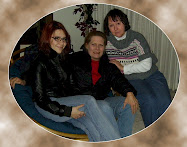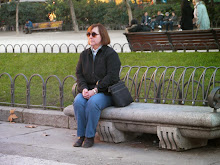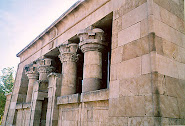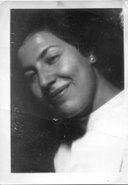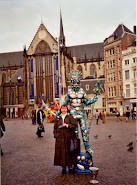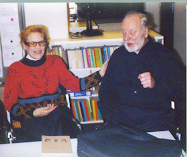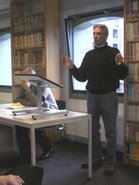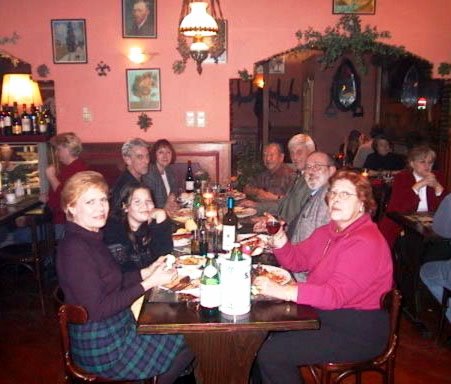 (Photograph: Goddess from Sheikhi Abad mound Iran, 2008 - horns of a red deer with a human face carved into the haft: The first phase of archeological excavations at Sheikhi Abad mound in Iran's Kermanshah Province has yielded the statue of a goddess. The statute, which resembles a figurine previously found in Kermanshah's Sarab-Mort, is believed by experts to be a valuable source of information.)
A fork - a "Y" symbol.
In symbology, the oldest definition of a fork is two-fold: "two horns," i.e., the horns of a cow, a bull, a deer (or gazelle, etc., like-related animals). In archaic times, many goddesses and gods appeared as horned entities - sometimes with one horn, sometimes with two horns. In later times, spiked crowns were substituted for the symbolic power of a horn or horns.
The fork "Y" symbol might also be construed as a long-stemmed glass or goblet - a Grail; and it might also be construed as the classic "delta" area leading to between a woman's legs.
The following is from Barbara G. Walker's The Woman's Encyclopedia of Myths and Secrets, under the entry Fork. She does not agree with my analysis:
Fork
"Furka" or "fork" described the so-called lost letter of the Greek alphabet, digrmma, a double gamma having the sound of F. Its Sanskrit name was forkwas, linguistic root of the two trees on which dying gods were sacrificed: Norse fyr (fir) and Latin quercus (oak).(1) The Egypotian furka was the Y-shaped cross on which the god Set was crucified. It was also a phallic symbol of the god's sacred marriage.(2) The "thieves' cross" in Christian iconography had the same shape. Such crosses flanking Jesus's cross may have represented sacred marriage. The Y-shaped fork was sometimes regarded as a female genital symbol, in conjunction with the male trident or three-pronged fork.(3)
The voodoo savior-god Legbh characteristically used as his crutch a derivative of the sacred furka of Set.(4)
Notes:
1. Potter & Sargent, 230.
2. Campbell, M. I., 29.
3. de Lys, 233.
4. Martello, 164.
(Photograph: Goddess from Sheikhi Abad mound Iran, 2008 - horns of a red deer with a human face carved into the haft: The first phase of archeological excavations at Sheikhi Abad mound in Iran's Kermanshah Province has yielded the statue of a goddess. The statute, which resembles a figurine previously found in Kermanshah's Sarab-Mort, is believed by experts to be a valuable source of information.)
A fork - a "Y" symbol.
In symbology, the oldest definition of a fork is two-fold: "two horns," i.e., the horns of a cow, a bull, a deer (or gazelle, etc., like-related animals). In archaic times, many goddesses and gods appeared as horned entities - sometimes with one horn, sometimes with two horns. In later times, spiked crowns were substituted for the symbolic power of a horn or horns.
The fork "Y" symbol might also be construed as a long-stemmed glass or goblet - a Grail; and it might also be construed as the classic "delta" area leading to between a woman's legs.
The following is from Barbara G. Walker's The Woman's Encyclopedia of Myths and Secrets, under the entry Fork. She does not agree with my analysis:
Fork
"Furka" or "fork" described the so-called lost letter of the Greek alphabet, digrmma, a double gamma having the sound of F. Its Sanskrit name was forkwas, linguistic root of the two trees on which dying gods were sacrificed: Norse fyr (fir) and Latin quercus (oak).(1) The Egypotian furka was the Y-shaped cross on which the god Set was crucified. It was also a phallic symbol of the god's sacred marriage.(2) The "thieves' cross" in Christian iconography had the same shape. Such crosses flanking Jesus's cross may have represented sacred marriage. The Y-shaped fork was sometimes regarded as a female genital symbol, in conjunction with the male trident or three-pronged fork.(3)
The voodoo savior-god Legbh characteristically used as his crutch a derivative of the sacred furka of Set.(4)
Notes:
1. Potter & Sargent, 230.
2. Campbell, M. I., 29.
3. de Lys, 233.
4. Martello, 164.
Saturday, October 31, 2009
Fork: A Symbol of the Goddess
 (Photograph: Goddess from Sheikhi Abad mound Iran, 2008 - horns of a red deer with a human face carved into the haft: The first phase of archeological excavations at Sheikhi Abad mound in Iran's Kermanshah Province has yielded the statue of a goddess. The statute, which resembles a figurine previously found in Kermanshah's Sarab-Mort, is believed by experts to be a valuable source of information.)
A fork - a "Y" symbol.
In symbology, the oldest definition of a fork is two-fold: "two horns," i.e., the horns of a cow, a bull, a deer (or gazelle, etc., like-related animals). In archaic times, many goddesses and gods appeared as horned entities - sometimes with one horn, sometimes with two horns. In later times, spiked crowns were substituted for the symbolic power of a horn or horns.
The fork "Y" symbol might also be construed as a long-stemmed glass or goblet - a Grail; and it might also be construed as the classic "delta" area leading to between a woman's legs.
The following is from Barbara G. Walker's The Woman's Encyclopedia of Myths and Secrets, under the entry Fork. She does not agree with my analysis:
Fork
"Furka" or "fork" described the so-called lost letter of the Greek alphabet, digrmma, a double gamma having the sound of F. Its Sanskrit name was forkwas, linguistic root of the two trees on which dying gods were sacrificed: Norse fyr (fir) and Latin quercus (oak).(1) The Egypotian furka was the Y-shaped cross on which the god Set was crucified. It was also a phallic symbol of the god's sacred marriage.(2) The "thieves' cross" in Christian iconography had the same shape. Such crosses flanking Jesus's cross may have represented sacred marriage. The Y-shaped fork was sometimes regarded as a female genital symbol, in conjunction with the male trident or three-pronged fork.(3)
The voodoo savior-god Legbh characteristically used as his crutch a derivative of the sacred furka of Set.(4)
Notes:
1. Potter & Sargent, 230.
2. Campbell, M. I., 29.
3. de Lys, 233.
4. Martello, 164.
(Photograph: Goddess from Sheikhi Abad mound Iran, 2008 - horns of a red deer with a human face carved into the haft: The first phase of archeological excavations at Sheikhi Abad mound in Iran's Kermanshah Province has yielded the statue of a goddess. The statute, which resembles a figurine previously found in Kermanshah's Sarab-Mort, is believed by experts to be a valuable source of information.)
A fork - a "Y" symbol.
In symbology, the oldest definition of a fork is two-fold: "two horns," i.e., the horns of a cow, a bull, a deer (or gazelle, etc., like-related animals). In archaic times, many goddesses and gods appeared as horned entities - sometimes with one horn, sometimes with two horns. In later times, spiked crowns were substituted for the symbolic power of a horn or horns.
The fork "Y" symbol might also be construed as a long-stemmed glass or goblet - a Grail; and it might also be construed as the classic "delta" area leading to between a woman's legs.
The following is from Barbara G. Walker's The Woman's Encyclopedia of Myths and Secrets, under the entry Fork. She does not agree with my analysis:
Fork
"Furka" or "fork" described the so-called lost letter of the Greek alphabet, digrmma, a double gamma having the sound of F. Its Sanskrit name was forkwas, linguistic root of the two trees on which dying gods were sacrificed: Norse fyr (fir) and Latin quercus (oak).(1) The Egypotian furka was the Y-shaped cross on which the god Set was crucified. It was also a phallic symbol of the god's sacred marriage.(2) The "thieves' cross" in Christian iconography had the same shape. Such crosses flanking Jesus's cross may have represented sacred marriage. The Y-shaped fork was sometimes regarded as a female genital symbol, in conjunction with the male trident or three-pronged fork.(3)
The voodoo savior-god Legbh characteristically used as his crutch a derivative of the sacred furka of Set.(4)
Notes:
1. Potter & Sargent, 230.
2. Campbell, M. I., 29.
3. de Lys, 233.
4. Martello, 164.
Hunter Killed by Own Gun
Games Other Than Chess: A Little News
2009 European Women's Team Chess Championship
 (Photo from Alexandra Kosteniuk's blog , Russian Women's Chess Team, Gold Medal Winners)
Wrap-up. Official website.Women's team medal winners:
1. Russia GOLD (E 7,000)
1. Russia (RUS / RtgAvg:2500 / TB1: 16 / TB2: 26)
Bo. Name Rtg Pts. Games Rp
1 GM Kosteniuk Alexandra 2516 6,0 8,0 2621
2 GM Kosintseva Tatiana 2536 5,0 8,0 2432
3 IM Kosintseva Nadezhda 2493 8,0 9,0 2665
4 IM Romanko Marina 2453 2,0 4,0 2243
5 WFM Gunina Valentina 2437 5,0 7,0 2422
2. Georgia SILVER (E 5,000)
2. Georgia (GEO / RtgAvg:2474 / TB1: 16 / TB2: 24)
Bo. Name Rtg Pts. Games Rp
1 GM Dzagnidze Nana 2535 4,0 8,0 2410
2 IM Javakhishvili Lela 2472 5,5 7,0 2599
3 IM Khukhashvili Sopiko 2451 5,0 7,0 2516
4 IM Khurtsidze Nino 2420 3,0 6,0 2349
5 IM Khotenashvili Bela 2438 6,5 8,0 2518
3. Ukraine BRONZE (E 3,000)
3. Ukraine (UKR / RtgAvg:2463 / TB1: 12 / TB2: 20)
Bo. Name Rtg Pts. Games Rp
1 GM Lahno Kateryna 2483 5,5 8,0 2593
2 WGM Zhukova Natalia 2457 4,5 8,0 2423
3 IM Ushenina Anna 2474 2,5 6,0 2304
4 IM Gaponenko Inna 2438 4,5 7,0 2428
5 WGM Zdebskaja Natalia 2410 3,0 7,0 2270
Individual medal winners (information from Alexandra Kosteniuk's blog):
1st Board:
Gold: Alexandra Kosteniuk (Russia) (E1,000)
Silver: Antoaneta Stefanova (Bulgaria) (E700)
Bronze: Kateryna Lahno (Ukraine) (E500)
2nd Board:
Gold: Lela Javakhishvili (Georgia) (E1,000)
Silver: Lilit Mktrchian (Armenia) (E700)
Bronze: Sophie Milliet (France) (E500)
3rd Board:
Gold: Nadezhda Kosintseva (Russia) (E1,000)
Silver: Sopiko Khukhashvili (Georgia) (E700)
Bronze: Lilit Galojan (Armenia) (E500)
4th Board:
Gold: Ekaterini Fakhiridou (Greece) (E1,000)
Silver: Joanna Dworakowska (Poland) (E700)
Bronze: Olga Vasiliev (Israel) (E500)
5th Board:
Gold: Joanna Majdan (Poland) (E1,000)
Silver: Bela Khotenashvili (Georgia) (E700)
Bronze: Valentina Gunina (Russia) (E500)
(Photo from Alexandra Kosteniuk's blog , Russian Women's Chess Team, Gold Medal Winners)
Wrap-up. Official website.Women's team medal winners:
1. Russia GOLD (E 7,000)
1. Russia (RUS / RtgAvg:2500 / TB1: 16 / TB2: 26)
Bo. Name Rtg Pts. Games Rp
1 GM Kosteniuk Alexandra 2516 6,0 8,0 2621
2 GM Kosintseva Tatiana 2536 5,0 8,0 2432
3 IM Kosintseva Nadezhda 2493 8,0 9,0 2665
4 IM Romanko Marina 2453 2,0 4,0 2243
5 WFM Gunina Valentina 2437 5,0 7,0 2422
2. Georgia SILVER (E 5,000)
2. Georgia (GEO / RtgAvg:2474 / TB1: 16 / TB2: 24)
Bo. Name Rtg Pts. Games Rp
1 GM Dzagnidze Nana 2535 4,0 8,0 2410
2 IM Javakhishvili Lela 2472 5,5 7,0 2599
3 IM Khukhashvili Sopiko 2451 5,0 7,0 2516
4 IM Khurtsidze Nino 2420 3,0 6,0 2349
5 IM Khotenashvili Bela 2438 6,5 8,0 2518
3. Ukraine BRONZE (E 3,000)
3. Ukraine (UKR / RtgAvg:2463 / TB1: 12 / TB2: 20)
Bo. Name Rtg Pts. Games Rp
1 GM Lahno Kateryna 2483 5,5 8,0 2593
2 WGM Zhukova Natalia 2457 4,5 8,0 2423
3 IM Ushenina Anna 2474 2,5 6,0 2304
4 IM Gaponenko Inna 2438 4,5 7,0 2428
5 WGM Zdebskaja Natalia 2410 3,0 7,0 2270
Individual medal winners (information from Alexandra Kosteniuk's blog):
1st Board:
Gold: Alexandra Kosteniuk (Russia) (E1,000)
Silver: Antoaneta Stefanova (Bulgaria) (E700)
Bronze: Kateryna Lahno (Ukraine) (E500)
2nd Board:
Gold: Lela Javakhishvili (Georgia) (E1,000)
Silver: Lilit Mktrchian (Armenia) (E700)
Bronze: Sophie Milliet (France) (E500)
3rd Board:
Gold: Nadezhda Kosintseva (Russia) (E1,000)
Silver: Sopiko Khukhashvili (Georgia) (E700)
Bronze: Lilit Galojan (Armenia) (E500)
4th Board:
Gold: Ekaterini Fakhiridou (Greece) (E1,000)
Silver: Joanna Dworakowska (Poland) (E700)
Bronze: Olga Vasiliev (Israel) (E500)
5th Board:
Gold: Joanna Majdan (Poland) (E1,000)
Silver: Bela Khotenashvili (Georgia) (E700)
Bronze: Valentina Gunina (Russia) (E500)
Friday, October 30, 2009
2009 European Women's Team Chess Championship
I Have Found Tatjana Plachkinova!
 Today, and I don't know why - during my lunch hour I once again hunted for Tatjana Plachinova, and came up with zero on Google. So, this time, I added a "k" to her last name, and - lo and behold - I found her!
(Photo: From 2008 European Women's Individual Chess Championship at Plovdid, by Chessbase - TJ is on the left)
Birthday 7/12/81, her first name is also sometimes spelled Tatyana and Tatiana.
TJ (this is what I called her in my emails) is still playing chess, although sporadically. Now that I am spelling her name correctly, I easily located her FIDE record. She has the WIM title (earned in 2003) and a current FIDE rating of 2148, and is still playing under the Bulgarian flag.
TJ's two most recent FIDE rated events:
The Campeonato de Catalnya d'Equipos Primera Division G-I between March 1, 2009 and March 29, 2009. I think it must be a league because they played over too long to a period to be a tournament! She finished with 4.0/9.
The Hogeschool Zeeland Chess Tournament 2009 (250 players) August 1 - 8, 2009, she finished with 4.5/9.
During our last contact, I remembered that TJ was going with GM Artur Kogan, who lived in Spain. I think they got married and have a child - that would account for the drop off in TJ's playing time, as motherhood and marriage is time consuming and becomes the first priority. It is very difficult for female chessplayers who are married and mothers to pursue their chess careers as professionals.
Check this out - I found this game TJ played against Magnus Carlsen in 2001 (yes, THE Magnus Carlsen, the kid born in 1990 who looks like he will break the 2800 ELO barrier this year, the same Magnus Carlsen currently under the tutledge of Kasparov).
Game
Site: Bergen
Date: 08/10/2001
Round: 7
Score: 0-1
ECO: D10 Queen's Gambit Declined Slav defence
1. d4 d5 2. c4 c6 3. Nc3 Nf6 4. Nf3 dxc4 5. a4 Bg4 6. e3 e6 7. Bxc4 Bb4 8. Qb3 a5 9. Ne5 Bh5 10. O-O Qc7 11. e4 O-O 12. Bf4 Qe7 13. Rfe1 Nbd7 14. Re3 Nxe5 15. dxe5 Nd7 16. Rg3 Nc5 17. Qc2 Bg6 18. Qe2 Bxc3 19. bxc3 Bxe4 20. Rd1 Bg6 21. Bg5 Qc7 22. h4 Ne4 23. h5 Nxg3 24. fxg3 Bf5 25. g4 Bc2 26. Qxc2 Qxe5 27. Be7 Rfe8 28. Bd6 Qe3+ 29. Kh2 Rad8 30. Bg3 h6 31. Qb3 Qc5 32. Rf1 Rd7 33. Be2 Red8 34. Bf3 b5 35. Bf2 bxa4 36. Qxa4 Qxc3 37. Qxc6 Qxc6 38. Bxc6 Rd1 39. Kg1 f6 40. Bb5 Kf7 41. Be3 Rxf1+ 42. Kxf1 Rb8 43. Bc6 Rb4 44. Bd2 Rc4 45. Bf3 a4 46. Be2 Rc2 47. Bb4 Rb2 48. Bd6 Rb1+ 49. Kf2 Rb3 0-1
TJ has bragging rights against a player who is probably a future World Chess Champion!
Today, and I don't know why - during my lunch hour I once again hunted for Tatjana Plachinova, and came up with zero on Google. So, this time, I added a "k" to her last name, and - lo and behold - I found her!
(Photo: From 2008 European Women's Individual Chess Championship at Plovdid, by Chessbase - TJ is on the left)
Birthday 7/12/81, her first name is also sometimes spelled Tatyana and Tatiana.
TJ (this is what I called her in my emails) is still playing chess, although sporadically. Now that I am spelling her name correctly, I easily located her FIDE record. She has the WIM title (earned in 2003) and a current FIDE rating of 2148, and is still playing under the Bulgarian flag.
TJ's two most recent FIDE rated events:
The Campeonato de Catalnya d'Equipos Primera Division G-I between March 1, 2009 and March 29, 2009. I think it must be a league because they played over too long to a period to be a tournament! She finished with 4.0/9.
The Hogeschool Zeeland Chess Tournament 2009 (250 players) August 1 - 8, 2009, she finished with 4.5/9.
During our last contact, I remembered that TJ was going with GM Artur Kogan, who lived in Spain. I think they got married and have a child - that would account for the drop off in TJ's playing time, as motherhood and marriage is time consuming and becomes the first priority. It is very difficult for female chessplayers who are married and mothers to pursue their chess careers as professionals.
Check this out - I found this game TJ played against Magnus Carlsen in 2001 (yes, THE Magnus Carlsen, the kid born in 1990 who looks like he will break the 2800 ELO barrier this year, the same Magnus Carlsen currently under the tutledge of Kasparov).
Game
Site: Bergen
Date: 08/10/2001
Round: 7
Score: 0-1
ECO: D10 Queen's Gambit Declined Slav defence
1. d4 d5 2. c4 c6 3. Nc3 Nf6 4. Nf3 dxc4 5. a4 Bg4 6. e3 e6 7. Bxc4 Bb4 8. Qb3 a5 9. Ne5 Bh5 10. O-O Qc7 11. e4 O-O 12. Bf4 Qe7 13. Rfe1 Nbd7 14. Re3 Nxe5 15. dxe5 Nd7 16. Rg3 Nc5 17. Qc2 Bg6 18. Qe2 Bxc3 19. bxc3 Bxe4 20. Rd1 Bg6 21. Bg5 Qc7 22. h4 Ne4 23. h5 Nxg3 24. fxg3 Bf5 25. g4 Bc2 26. Qxc2 Qxe5 27. Be7 Rfe8 28. Bd6 Qe3+ 29. Kh2 Rad8 30. Bg3 h6 31. Qb3 Qc5 32. Rf1 Rd7 33. Be2 Red8 34. Bf3 b5 35. Bf2 bxa4 36. Qxa4 Qxc3 37. Qxc6 Qxc6 38. Bxc6 Rd1 39. Kg1 f6 40. Bb5 Kf7 41. Be3 Rxf1+ 42. Kxf1 Rb8 43. Bc6 Rb4 44. Bd2 Rc4 45. Bf3 a4 46. Be2 Rc2 47. Bb4 Rb2 48. Bd6 Rb1+ 49. Kf2 Rb3 0-1
TJ has bragging rights against a player who is probably a future World Chess Champion!
2009 European Women's Team Chess Championship
The final round is today. Here are the match-ups: No. SNo Team Team Pts. MP Res. : Res. MP Pts. Team Team SNo 1 1 RUS Russia 23½ 14 : 11 19½ Armenia ARM 5 2 13 ROU Romania 17½ 10 : 14 21½ Georgia GEO 2 3 16 CZE Czech Republic 17½ 10 : 11 18 Ukraine UKR 3 4 9 SRB Serbia 14½ 7 : 8 15 Israel ISR 17 5 12 SLO Slovenia 19½ 10 : 10 17½ Azerbaijan AZE 20 6 14 GRE Greece 18 9 : 9 18 France FRA 6 7 15 ESP Spain 16 9 : 8 19 Poland POL 4 8 7 GER Germany 16 8 ½ : ½ 8 17 Italy ITA 19 9 8 BUL Bulgaria 14 8 : 8 17 Hungary HUN 10 10 21 AUT Austria 14 7 : 7 15 Croatia CRO 18 11 26 FIN Finland 10½ 3 : 7 17½ Netherlands NED 11 12 22 ENG England 16 6 : 5 10 Turkey TUR 28 13 23 MNE Montenegro 14 6 1 : 1 3 10 Norway NOR 27 14 25 MKD Former Yug Rep of Macedonia 11 4 : 4 11 Bosnia & Herzegovina BIH 24
Top PR after R8: No. Name Rtg Team Rp Pts. Games % Bo. 1 GM Kosteniuk Alexandra 2516 Russia 2649 5,5 7 78,6 1 2 IM Kosintseva Nadezhda 2493 Russia 2648 7,0 8 87,5 2 3 GM Lahno Kateryna 2483 Ukraine 2618 5,0 7 71,4 1 4 IM Javakhishvili Lela 2472 Georgia 2599 5,5 7 78,6 1 5 WGM Majdan Joanna 2361 Poland 2598 6,0 7 85,7 4 6 IM Mkrtchian Lilit 2469 Armenia 2573 6,0 8 75,0 2 7 WGM Mamedjarova Zeinab 2285 Azerbaijan 2570 4,5 7 64,3 1 8 GM Stefanova Antoaneta 2527 Bulgaria 2561 5,0 7 71,4 1 9 WGM Galojan Lilit 2326 Armenia 2560 5,5 7 78,6 3 10 IM Khukhashvili Sopiko 2451 Georgia 2546 4,5 6 75,0 2
Thursday, October 29, 2009
The Complex Traditions of the Diwali Celebration
 Article from The Times of India.
Photo from an article in the Daily Mail Online, November 10, 2007, I could not find a photo credit. Caption:
Workers could take time off for the Hindu celebration of Diwali - the festival of lights.
October 18, 2009
Diwali celebrations: A melange of traditions
By Nidhi Singhi
LUDHIANA: While Diwali is celebrated all across the country with same enthusiasm and fervour, it holds different meanings for various communities. While Bengali community celebrated it by worshipping Goddess Kali on Diwali night, people belonging to south Indian community marked the day commemorating victory of Lord Krishna over demon Narkasur.
Bengalis worship Goddess Lakshmi five days after Dussehra, but on Diwali, they worship goddess Kali. Devotees believe that Kali is the aggressive form or the destructive incarnation of Goddess Durga, but Bengalis celebrated the festival by worshipping goddess Kali, because she destroys the evil and in turn, she promises rejuvenation of life and justice on earth.
Among south Indians, it is believed that Diwali celebrations are simply for commemoration of victory of Lord Krishna who killed Narkasur, a powerful king of Assam, who had imprisoned various inhabitants and had been freed by the Lord on this day so Diwali is also known as Naraka Chaturdasi. Some devotees also believe that Narkasur had requested the Lord to fulfil his last wish that he wanted to enjoy the last day of his life in a grand manner and the practice thus continued.
Describing celebrations, TK Banerjee, secretary, Bangia Samsad, said it is a tradition in their community to decorate the house with 14 candles a day prior to festival to keep ghosts away from their houses.
Since they could not use fried sweets in the worship, they used plain burfi solely prepared by ladies of their homes but one sweet called nadu, served after havana, is liked by all.
R Sidhartan, a member of south Indian community, said it is just the traditions that differ but the purpose of festivals is to celebrate it with friends and family members. He said Diwali celebrations include a visit to the temple, gifts of clothes and jewellery, gorging on sweets and receiving blessings of elders.
Article from The Times of India.
Photo from an article in the Daily Mail Online, November 10, 2007, I could not find a photo credit. Caption:
Workers could take time off for the Hindu celebration of Diwali - the festival of lights.
October 18, 2009
Diwali celebrations: A melange of traditions
By Nidhi Singhi
LUDHIANA: While Diwali is celebrated all across the country with same enthusiasm and fervour, it holds different meanings for various communities. While Bengali community celebrated it by worshipping Goddess Kali on Diwali night, people belonging to south Indian community marked the day commemorating victory of Lord Krishna over demon Narkasur.
Bengalis worship Goddess Lakshmi five days after Dussehra, but on Diwali, they worship goddess Kali. Devotees believe that Kali is the aggressive form or the destructive incarnation of Goddess Durga, but Bengalis celebrated the festival by worshipping goddess Kali, because she destroys the evil and in turn, she promises rejuvenation of life and justice on earth.
Among south Indians, it is believed that Diwali celebrations are simply for commemoration of victory of Lord Krishna who killed Narkasur, a powerful king of Assam, who had imprisoned various inhabitants and had been freed by the Lord on this day so Diwali is also known as Naraka Chaturdasi. Some devotees also believe that Narkasur had requested the Lord to fulfil his last wish that he wanted to enjoy the last day of his life in a grand manner and the practice thus continued.
Describing celebrations, TK Banerjee, secretary, Bangia Samsad, said it is a tradition in their community to decorate the house with 14 candles a day prior to festival to keep ghosts away from their houses.
Since they could not use fried sweets in the worship, they used plain burfi solely prepared by ladies of their homes but one sweet called nadu, served after havana, is liked by all.
R Sidhartan, a member of south Indian community, said it is just the traditions that differ but the purpose of festivals is to celebrate it with friends and family members. He said Diwali celebrations include a visit to the temple, gifts of clothes and jewellery, gorging on sweets and receiving blessings of elders.
Babylonian Contact with the Hyksos in Egypt
 From the Austriantimes.at
Austrian archaeologists make Babylonian find in Egypt
October 29, 2009
By Lisa Chapman
(Photo Credit: (c) Axel Krause)
Austrian archaeologists have found a Babylonian seal in Egypt that confirms contact between the Babylonians and the Hyksos during the second millennium B.C.
Irene Forstner-Müller, the head of the Austrian Archaeological Institute’s (ÖAI) branch office in Cairo, said today (Thurs) the find had occurred at the site of the ancient town of Avaris near what is today the city of Tell el-Dab’a in the eastern Nile delta.
The Hyksos conquered Egypt and reigned there from 1640 to 1530 B.C. She said a recently-discovered cuneiform tablet had led archaeologists to suspect there had been contact between the Babylonians and the Hyksos.
Forstner-Müller added that Manfred Bietak had begun archaeological research on the period of Hyksos dominance at the remains of a Hyksos palace at Avaris in 1966. She said ÖAI would open a museum at the Avaris site that the Egyptian government and sponsors would fund to make the seal and other objects accessible to tourists.
From the Austriantimes.at
Austrian archaeologists make Babylonian find in Egypt
October 29, 2009
By Lisa Chapman
(Photo Credit: (c) Axel Krause)
Austrian archaeologists have found a Babylonian seal in Egypt that confirms contact between the Babylonians and the Hyksos during the second millennium B.C.
Irene Forstner-Müller, the head of the Austrian Archaeological Institute’s (ÖAI) branch office in Cairo, said today (Thurs) the find had occurred at the site of the ancient town of Avaris near what is today the city of Tell el-Dab’a in the eastern Nile delta.
The Hyksos conquered Egypt and reigned there from 1640 to 1530 B.C. She said a recently-discovered cuneiform tablet had led archaeologists to suspect there had been contact between the Babylonians and the Hyksos.
Forstner-Müller added that Manfred Bietak had begun archaeological research on the period of Hyksos dominance at the remains of a Hyksos palace at Avaris in 1966. She said ÖAI would open a museum at the Avaris site that the Egyptian government and sponsors would fund to make the seal and other objects accessible to tourists.
Chess Femme News
Computer Labs for Kids: Update
Wednesday, October 28, 2009
2009 European Women's Team Chess Championship
Tuesday, October 27, 2009
Knights (and Knightesses) of Mill Valley Chess Team
 First Photo: Mr. Seghers wrote: "We meet on the stage, there is no other place for us! Works out pretty good."
I don't know - it looks pretty crowded to me on that stage, but the players look intent! No chairs for the kids. On the other hand, the tables are almost as tall as some of the players, so it is probably easier to stand and play than to sit and try to play in a chair that would be too low to the board!
First Photo: Mr. Seghers wrote: "We meet on the stage, there is no other place for us! Works out pretty good."
I don't know - it looks pretty crowded to me on that stage, but the players look intent! No chairs for the kids. On the other hand, the tables are almost as tall as some of the players, so it is probably easier to stand and play than to sit and try to play in a chair that would be too low to the board!
 Second photo: Some of the young ladies of the Knights (actually, they are Knightesses) of the Mill Valley Chess Team. They are all Gorgeous! YOU GO GIRLS! Perhaps we have a future #1 in the world in this picture.
Thanks for the photos, Mr. Seghers. I will be following along on the blog for future news and please feel free to send me more photos of the chess femmes in action!
Second photo: Some of the young ladies of the Knights (actually, they are Knightesses) of the Mill Valley Chess Team. They are all Gorgeous! YOU GO GIRLS! Perhaps we have a future #1 in the world in this picture.
Thanks for the photos, Mr. Seghers. I will be following along on the blog for future news and please feel free to send me more photos of the chess femmes in action!
Interesting Carved Stones Found Near Church Ruins
 Oh no - at the very end of this article, they mention an old legend about buried treasure. Now that this tombstone(?) or sarcophogus(?) cover has been found, you know what's bound to happen - hordes of treasure hunters will descend upon this site, and they're probably not going to be signing up and staying at the local inn and shopping in the local village shops!
From the News.scotsman.com
Mystery stone found near church linked to Knights Templar
Published Date: 27 October 2009
By CLAIRE SMITH
A MYSTERIOUS carved stone has been uncovered alongside a 12th-century church associated with the Knights Templar.
The stone has been dated to the 12th century. Pictures: Kate Chandler
What appears to be the carved top of a sarcophagus was unearthed when builders were excavating and reinforcing a wall alongside the old ruined church in Temple, Midlothian. But the inscriptions, which include symbols similar to those found in Viking monuments, in medieval graves and in West Highland Celtic carvings, have baffled archaeologists.
Crispin Phillips, who is renovating a house alongside The Old Parish Church, said: "I was on a mission to repair the wall – which was falling into the graveyard. We got near the bottom of the foundations and found something buried there.
"We found one stone carved with a cross and then another with these carvings on it." He added: "We spent about half an hour in philosophical discussions about what we should do about it. I felt we should do something, rather than just bury it again."
Mr Phillips contacted Historic Scotland and East Lothian Council, whose archaeologists cover Midlothian. He said the stone had been photographed and recorded but he was still unclear whether further investigations would be carried out.
"One of the archaeologists who came out told us it was probably from the early 12th century," he added. "But really I'm still in limbo about what to do about it."
Historian and author John Ritchie said the stone raised many questions. "It is a crude carving, quite primitive, but I have never seen anything like it in my life," he said. "It has a whole series of symbols on it and the symbols are very interesting."
The symbols at the bottom look like Viking sun compasses, while the dials at the top look a little bit like a Celtic cross but with notches carved on them. Expert David Connolly, of Connolly Heritage Consultancy, said he believed the stone was from the 13th or 14th century.
"It is a significant site because it was the Templar Preceptory for Scotland," he said. "I think from the condition, it may once have been set inside the church – which was once much bigger," he added. "He could be a Templar, he could be a Hospitaller, he could just be a knight who wanted to be buried there – but the heraldry is like nothing anyone has seen before." He added that he hoped further study of the stone was possible in the future.
Mr Phillips said he planned to complete the rebuilding of the 17th-century graveyard wall and would build an arch into it so the half-buried carvings could still be seen by interested scholars. However historian and author Michael Turnbull said he doubted the find was significant: "There were certainly Templars there but this might be a fake."
Village legend tells of long-lost buried treasure
THE village of Temple in Midlothian takes its name from the Knights Templar, who once had their Scottish Preceptory – their headquarters – there.
The ruined chapel, which nestles in the valley at the foot of the village, is all that remains of what was once an abbey founded by the Templars on lands gifted by David I of Scotland in 1127.
Founded during the Crusades, the Templars was a religious order of knights whose mission was to protect Christians in the Holy Land.Some say they invented international banking, with a system of credit letters used to pass funds to people fighting in the Crusades. The Templars certainly grew rich and powerful. According to some accounts they were the holders of treasures from Jerusalem. But the organisation came under suspicion from the royalty of Europe and the Catholic Church. Templars were hunted down and burned at the stake. Legend has it some of those fleeing persecution hid in this Midlothian village – bringing their treasure with them.
According to local legend some of this treasure still lies buried in Temple: "Twixt the oak and the elm tree/You will find buried the millions free."
Oh no - at the very end of this article, they mention an old legend about buried treasure. Now that this tombstone(?) or sarcophogus(?) cover has been found, you know what's bound to happen - hordes of treasure hunters will descend upon this site, and they're probably not going to be signing up and staying at the local inn and shopping in the local village shops!
From the News.scotsman.com
Mystery stone found near church linked to Knights Templar
Published Date: 27 October 2009
By CLAIRE SMITH
A MYSTERIOUS carved stone has been uncovered alongside a 12th-century church associated with the Knights Templar.
The stone has been dated to the 12th century. Pictures: Kate Chandler
What appears to be the carved top of a sarcophagus was unearthed when builders were excavating and reinforcing a wall alongside the old ruined church in Temple, Midlothian. But the inscriptions, which include symbols similar to those found in Viking monuments, in medieval graves and in West Highland Celtic carvings, have baffled archaeologists.
Crispin Phillips, who is renovating a house alongside The Old Parish Church, said: "I was on a mission to repair the wall – which was falling into the graveyard. We got near the bottom of the foundations and found something buried there.
"We found one stone carved with a cross and then another with these carvings on it." He added: "We spent about half an hour in philosophical discussions about what we should do about it. I felt we should do something, rather than just bury it again."
Mr Phillips contacted Historic Scotland and East Lothian Council, whose archaeologists cover Midlothian. He said the stone had been photographed and recorded but he was still unclear whether further investigations would be carried out.
"One of the archaeologists who came out told us it was probably from the early 12th century," he added. "But really I'm still in limbo about what to do about it."
Historian and author John Ritchie said the stone raised many questions. "It is a crude carving, quite primitive, but I have never seen anything like it in my life," he said. "It has a whole series of symbols on it and the symbols are very interesting."
The symbols at the bottom look like Viking sun compasses, while the dials at the top look a little bit like a Celtic cross but with notches carved on them. Expert David Connolly, of Connolly Heritage Consultancy, said he believed the stone was from the 13th or 14th century.
"It is a significant site because it was the Templar Preceptory for Scotland," he said. "I think from the condition, it may once have been set inside the church – which was once much bigger," he added. "He could be a Templar, he could be a Hospitaller, he could just be a knight who wanted to be buried there – but the heraldry is like nothing anyone has seen before." He added that he hoped further study of the stone was possible in the future.
Mr Phillips said he planned to complete the rebuilding of the 17th-century graveyard wall and would build an arch into it so the half-buried carvings could still be seen by interested scholars. However historian and author Michael Turnbull said he doubted the find was significant: "There were certainly Templars there but this might be a fake."
Village legend tells of long-lost buried treasure
THE village of Temple in Midlothian takes its name from the Knights Templar, who once had their Scottish Preceptory – their headquarters – there.
The ruined chapel, which nestles in the valley at the foot of the village, is all that remains of what was once an abbey founded by the Templars on lands gifted by David I of Scotland in 1127.
Founded during the Crusades, the Templars was a religious order of knights whose mission was to protect Christians in the Holy Land.Some say they invented international banking, with a system of credit letters used to pass funds to people fighting in the Crusades. The Templars certainly grew rich and powerful. According to some accounts they were the holders of treasures from Jerusalem. But the organisation came under suspicion from the royalty of Europe and the Catholic Church. Templars were hunted down and burned at the stake. Legend has it some of those fleeing persecution hid in this Midlothian village – bringing their treasure with them.
According to local legend some of this treasure still lies buried in Temple: "Twixt the oak and the elm tree/You will find buried the millions free."
Donegal Shrine Virgin 'Comes to Life'
 A Virgin Mary apparition site - and some very interesting happenings earlier this month.
From The Belfast Telegraph
Donegal grotto statue 'took on human form'
Friday, 2 October 2009
Visitors to a remote grotto have claimed a statue wept and crosses appeared and disappeared in the night sky this week.
A group of 14 people, who had gathered at the statue of the Virgin Mary, in a rocky outcrop near the town of Dungloe, Co Donegal, on Tuesday night, were transfixed as they watched the phenomenon, which they said lasted almost an hour.
"It was a crazy evening. It was absolutely amazing. I am still on an emotional high. All but one person seemed to see the same thing," recalled James Boyle, from Ardara, who was at the site with his wife Margaret and children, Martin (10) and Mary (11).
The Kerrytown shrine is visited by thousands of pilgrims annually, after first becoming the subject of a religious apparition 70 years ago.
James explained how the group had been drawn there last Tuesday night because of a claim by Ballyfermot-based faith healer Joe Coleman that the Virgin Mary had told him in a channelled message that she would appear at the shrine on September 29 at 8pm.
"We went into the shelter facing the rock and at a few minutes to eight someone suggested we should start the rosary. We had no sooner started than someone shouted 'look up'.
"To the left of the cross, another cross appeared in the sky and as soon as it disappeared, another one appeared. It lasted about 10 minutes," he explained.
Then people began noticing that the white statue with its red heart had begun changing colour and form.
"She appeared to have a human face and her head turned and she looked at people. She looked down at the children who were at the front," he said.
One woman explained how the statue began crying and she went up to dry the tears.
"The tears were running down from her eyes," she told Highland Radio.
Speaking to the Irish Independent from his Dublin home, Mr Coleman said that the Virgin Mary, who has been appearing to him for many years, had communicated to him that she would make herself known at Kerrytown on September 29.
He had passed on the details of that message to a small group of people who attended a healing service organised by him in Dungloe last June.
He added that a lot of priests in Co Donegal did not believe he was doing his healing work for the love of God.
Dungloe parish priest, Father Seamus Meehan, said last night that there had been talk about the Kerrytown grotto for years.
"But I would be kind of sceptical about it myself," he added.
A Virgin Mary apparition site - and some very interesting happenings earlier this month.
From The Belfast Telegraph
Donegal grotto statue 'took on human form'
Friday, 2 October 2009
Visitors to a remote grotto have claimed a statue wept and crosses appeared and disappeared in the night sky this week.
A group of 14 people, who had gathered at the statue of the Virgin Mary, in a rocky outcrop near the town of Dungloe, Co Donegal, on Tuesday night, were transfixed as they watched the phenomenon, which they said lasted almost an hour.
"It was a crazy evening. It was absolutely amazing. I am still on an emotional high. All but one person seemed to see the same thing," recalled James Boyle, from Ardara, who was at the site with his wife Margaret and children, Martin (10) and Mary (11).
The Kerrytown shrine is visited by thousands of pilgrims annually, after first becoming the subject of a religious apparition 70 years ago.
James explained how the group had been drawn there last Tuesday night because of a claim by Ballyfermot-based faith healer Joe Coleman that the Virgin Mary had told him in a channelled message that she would appear at the shrine on September 29 at 8pm.
"We went into the shelter facing the rock and at a few minutes to eight someone suggested we should start the rosary. We had no sooner started than someone shouted 'look up'.
"To the left of the cross, another cross appeared in the sky and as soon as it disappeared, another one appeared. It lasted about 10 minutes," he explained.
Then people began noticing that the white statue with its red heart had begun changing colour and form.
"She appeared to have a human face and her head turned and she looked at people. She looked down at the children who were at the front," he said.
One woman explained how the statue began crying and she went up to dry the tears.
"The tears were running down from her eyes," she told Highland Radio.
Speaking to the Irish Independent from his Dublin home, Mr Coleman said that the Virgin Mary, who has been appearing to him for many years, had communicated to him that she would make herself known at Kerrytown on September 29.
He had passed on the details of that message to a small group of people who attended a healing service organised by him in Dungloe last June.
He added that a lot of priests in Co Donegal did not believe he was doing his healing work for the love of God.
Dungloe parish priest, Father Seamus Meehan, said last night that there had been talk about the Kerrytown grotto for years.
"But I would be kind of sceptical about it myself," he added.
2009 European Women's Team Chess Championship
Monday, October 26, 2009
Festival of the Nine Gods (Sons of Dou Mu)
 Taoists celebrate the nine sons of the Dou Mu, Goddess of the North Star.
From the Malaysian Star Online
Tuesday October 27, 2009
Thousands pay homage to Nine Emperor Gods
By ANDREA FILMER
GEORGE TOWN: After nine days on earth, the Nine Emperor Gods were ushered back to the waterways in a grand ceremonial send-off to heaven.
Thousands of Taoist devotees flocked to temples in Penang last night to pay homage to the deities at the end of the annual nine-day vegetarian festival.
The festival, which began on Oct 18 or the first day of the ninth lunar month, is held to honour the nine sons of Dou Mu, the Goddess of the North Star.
In this old historic city, several of the normally quiet streets were brought to life by the clashing of cymbals and lively chatter.
Residents in the inner city were seen coming out of their pre-war shophouses or watching processions from the windows of their upper floors.
At the Tow Boh Keong Kew Ong Tai Tay temple on Macallum Street, devotees dressed in white ushered majestic floats and sedan chairs upon which the deities “rested’” onto the streets. Mediums with long whips fell into trances and had their cheeks pierced with 5m-long metal skewers before leading devotees to the Weld Quay seafront.
At the waterways (believed to be the place where deities arrive and depart) on both Weld Quay and Gurney Drive, devotees from temples all over the island gathered to send off the nine “ren huang” or human sovereigns in boat-shaped floats.
When brought out far enough, the floats were set ablaze to symbolise the departing of the deities to heaven.
More information on the Goddess Dou Mu:
**Dou-mu (at Encyclopedia Mythica)
by Micha F. Lindemans
The Chinese goddess who supervises the register in which the life and death of each person is recorded. She is venerated by those who wish a long life and personal compassion. Her name means "Mother of the Great Wagon".
Dou-mu is portrayed sitting on a lotus throne and has four heads, with three eyes in each, and eight arms -- four on each side of her body. In Taoist temples a hall is often dedicated to her. She is also venerated by Chinese Buddhists.
Taoists celebrate the nine sons of the Dou Mu, Goddess of the North Star.
From the Malaysian Star Online
Tuesday October 27, 2009
Thousands pay homage to Nine Emperor Gods
By ANDREA FILMER
GEORGE TOWN: After nine days on earth, the Nine Emperor Gods were ushered back to the waterways in a grand ceremonial send-off to heaven.
Thousands of Taoist devotees flocked to temples in Penang last night to pay homage to the deities at the end of the annual nine-day vegetarian festival.
The festival, which began on Oct 18 or the first day of the ninth lunar month, is held to honour the nine sons of Dou Mu, the Goddess of the North Star.
In this old historic city, several of the normally quiet streets were brought to life by the clashing of cymbals and lively chatter.
Residents in the inner city were seen coming out of their pre-war shophouses or watching processions from the windows of their upper floors.
At the Tow Boh Keong Kew Ong Tai Tay temple on Macallum Street, devotees dressed in white ushered majestic floats and sedan chairs upon which the deities “rested’” onto the streets. Mediums with long whips fell into trances and had their cheeks pierced with 5m-long metal skewers before leading devotees to the Weld Quay seafront.
At the waterways (believed to be the place where deities arrive and depart) on both Weld Quay and Gurney Drive, devotees from temples all over the island gathered to send off the nine “ren huang” or human sovereigns in boat-shaped floats.
When brought out far enough, the floats were set ablaze to symbolise the departing of the deities to heaven.
More information on the Goddess Dou Mu:
**Dou-mu (at Encyclopedia Mythica)
by Micha F. Lindemans
The Chinese goddess who supervises the register in which the life and death of each person is recorded. She is venerated by those who wish a long life and personal compassion. Her name means "Mother of the Great Wagon".
Dou-mu is portrayed sitting on a lotus throne and has four heads, with three eyes in each, and eight arms -- four on each side of her body. In Taoist temples a hall is often dedicated to her. She is also venerated by Chinese Buddhists.














